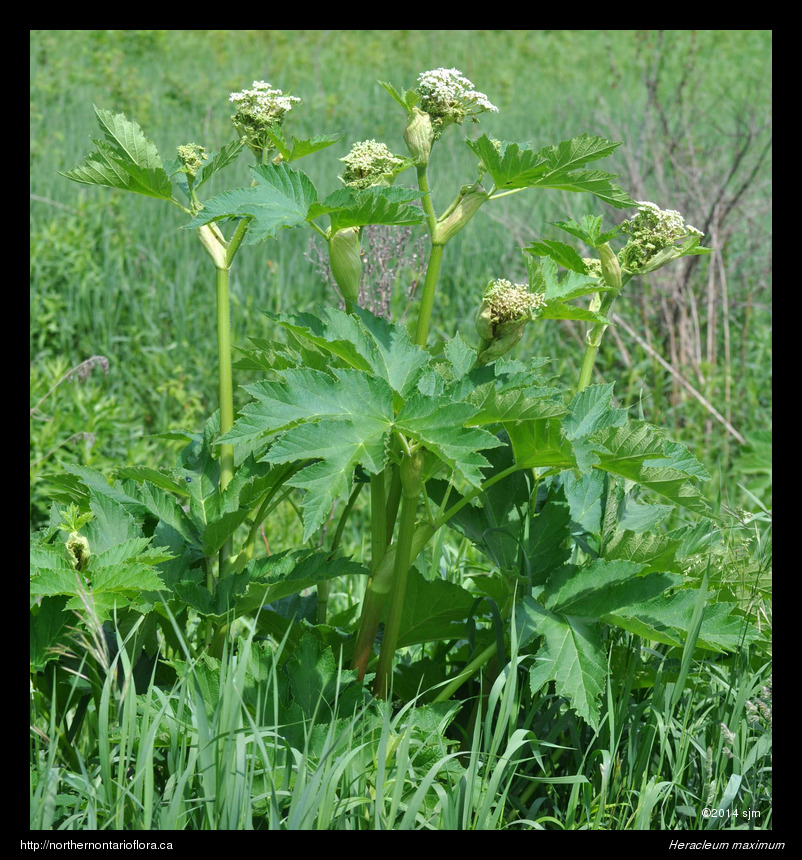
|
Northern Ontario Plant Database 
Plant DescriptionHeracleum maximum W.BartramEn: cow parsnip, common cow parsnip, masterwort
Apiaceae (Parsley Family) General: A stout perennial herb, 1—3 m tall. Warning: The sap of cow parsnip contains phototoxic compounds (furocoumarin) that can produce a type of rash called phytophotodermatitis (PPD). Boots, long sleeves, and long-legged pants should be worn if walking through stands of cow parsnip. Parents should teach their children how to recognize this plant and avoid it, as it often grows along the shorelines of ponds and streams. Synonym: Heracleum lanatum Michx. Stems: Non-woody (herbaceous), erect, hollow, and 1—5 cm in diameter; stems are ribbed, usually green, and covered with short stiff hairs. Stems may occasionally be purplish, but they are not spotted, nor are areas with purplish colouration raised into bumps, as in giant hogweed. Leaves: Basal and cauline (alternate), large and compound, divided into 3 main leaflets (ternately compound), 1.5—6 dm long and wide, and stiffly hairy on the lower surface. Petioles are broad and expanded (inflated) at the base, enclosing the developing leaves or flowers. Each leaflet is irregularly cut (incised) into 3 or more lobes; the terminal leaflet is somewhat longer and wider than the 2 stalked lateral leaflets. Leaflet bases are broad to slightly cordate, lateral leaflet bases may be asymmetric; tips of the lobes are sharply pointed (acuminate), and margins are coarsely toothed (serrate). Flowers: White, numerous, and borne in large flat-topped clusters (compound umbels), 10—20+ cm across. Inflorescences are terminal or in the upper leaf axils, subtended by 5—10 small bracts, and have 15—30 main branches (rays) that support smaller umbels, each subtended by an involucel of smaller bracts. Individual flower stalks (pedicels) are 8—20 mm long. Flowers are somewhat fragrant, have 5 small inconspicuous calyx lobes, 5 white petals, 5 stamens, and an inferior ovary of 2 carpels, topped by the enlarged nectar-secreting base (stylopodium) of the 2 styles. The outer petals of flowers at the edge of each umbel are enlarged and deeply divided into 2 lobes; other petals are unlobed. Flowers bloom in late spring to early summer. Fruit: The light brown dry fruits (schizocarps) are composed of 2 flat portions (mericarps), each containing a single seed. Fruits are numerous, occur in large flat-topped clusters, and mature in late summer. The 2 mericarps are held together at the top by the enlarged stylopodium and are attached to the flowering stalk (pedicel) by a small 2-branched structure called a carpophore. Each mericarp is flat, obovate (with a small depression at the top), and 7—12 mm long. Mericarps are marked with 4 dark brown oil tubes (vittae) that extend about halfway down the outer surface and 2 shorter oil tubes on the inner surface. When mature, the schizocarps break apart, shedding the individual mericarps. Habitat and Range: Streambanks, shorelines, moist low ground, and moist to wet roadsides. Cow parsnip is native to boreal North America and East Asia; it is found throughout most of Canada, with the exception of Nunavut. In Ontario, its range extends across the Province and north to Hudson Bay. Similar Species: Our native cow parsnip is often misidentified as giant hogweed (Heracleum mantegazzianum Sommier & Levier), a highly invasive Asian species, which is similar in appearance but much larger (to 5 m tall), has purple-spotted or blotched bristly stems, larger more divided leaves, and broader flower clusters than cow parsnip. Giant hogweed has not been found in the Algoma District. In Ontario, it has been reported from Manitoulin Island, but is more common in southern Ontario. Numerous erroneous reports each year of giant hogweed in Algoma are based on misidentifications of cow parsnip. Toxicity: A burning, often blistering, rash that resembles a poison ivy rash will develop when bare moist skin contacts sap from bruised or torn cow parsnip leaves or stems and then exposed to sunlight (UV rays). Exposure to both sunlight and the sap are required to cause this rash, which will develop within 1—3 days. Exposed skin should be washed immediately with soapy water, then bandaged to avoid further exposure to sunlight. If a rash develops, SEE YOUR DOCTOR for treatment as soon as possible; topical steroids may be prescribed for severe rashes. Unlike poison ivy, this rash does not respond to calamine lotion, but cool wet compresses are reported to lessen discomfort. After healing, skin will be more darkly coloured and extremely sensitive to UV light for months to years. Since the reaction is more like a chemical burn than an allergic reaction, no one is immune. When working or brush-cutting around cow parsnip, full protective clothing, gloves, and safety glasses should be worn. Back to species list |
||||||||||||||||||||||






















